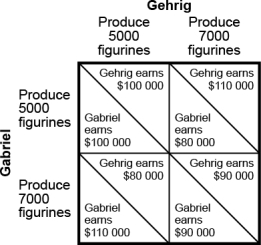Use the following to answer questions :
Figure: Payoff Matrix for Gehrig and Gabriel 
-(Figure: Payoff Matrix for Gehrig and Gabriel) Use Figure: Payoff Matrix for Gehrig and Gabriel.The figure describes two people who sell handmade Carey Price figurines in Montreal.Both Gehrig and Gabriel have two strategies available to them: to produce 5 000 figurines each month or to produce 7 000 figurines each month.If both follow a tit-for-tat strategy,equilibrium will be reached when Gehrig produces _____ figurines and Gabriel produces _____ figurines.
Definitions:
Team Task Analysis
The process of identifying, analyzing, and describing the tasks, responsibilities, and processes of a team within an organization.
Observable Action
An action or behavior that can be seen and measured, often used in performance assessments or research to evaluate outcomes.
Measurable Criterion
A quantifiable or assessable standard used to evaluate the success or effectiveness of a program or project.
Training Objective
The specific goal or outcome that a training program aims to achieve, which guides the development, delivery, and evaluation of the training.
Q33: A monopolist generally _ than does a
Q87: (Figure: Firms in Monopolistic Competition)Use Figure: Firms
Q107: (Figure: Profits in Monopolistic Competition)Use Figure: Profits
Q116: Price discrimination leads to a _ price
Q158: Suppose a monopolist reduces its price in
Q176: (Figure: Monopoly Profits in Duopoly)Use Figure: Monopoly
Q203: Because of monopoly,consumers experience _ than they
Q224: The ability of a monopolist to raise
Q232: (Table: Demand Schedule of Gadgets)Use Table: Demand
Q254: The natural monopoly:<br>A) would incur an economic